Home Decor
How to Choose the Perfect Interior Decor for Your Home!
Keen to transform your space? Discover essential tips for choosing the perfect interior decor that reflects your unique style and enhances your home’s flow.
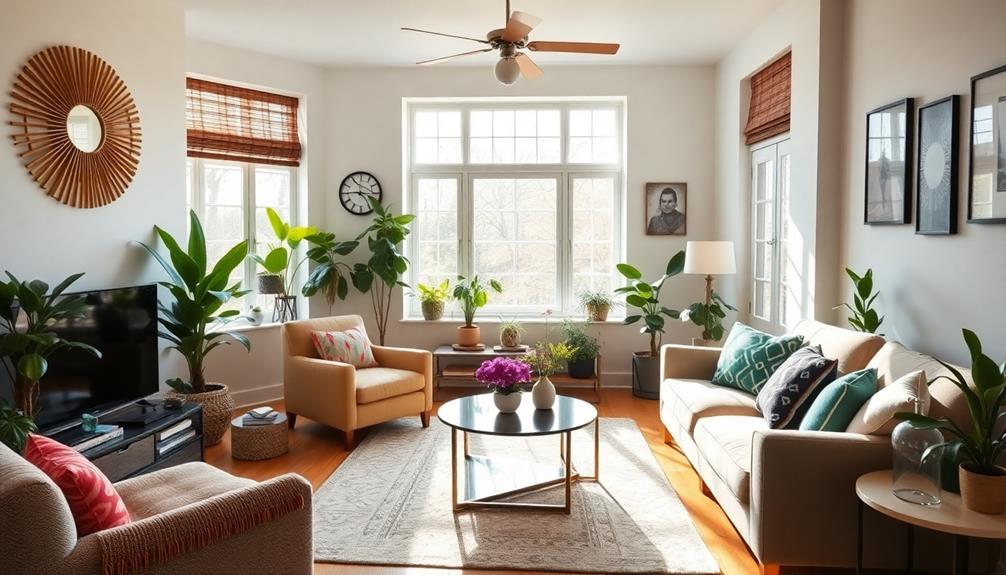
Choosing the perfect interior decor for your home starts with understanding your personal style. Reflect on your favorite colors and materials, considering whether you prefer modern or traditional design. Select a balanced color palette—incorporating both warm and cool tones—and mix textures for visual interest. Explore popular styles like Scandinavian or Mid-Century Modern to find inspiration. Don't forget about functional spaces; effective layout enhances your home's flow. Finally, create a mood board to visualize your selections. By focusing on these elements, you'll craft a space that feels uniquely yours. You'll uncover even more tips soon!
Key Takeaways
- Reflect on your personal style by considering favorite colors, materials, and design aesthetics to create a cohesive look.
- Choose a color palette that balances warm and cool tones, enhancing mood and atmosphere while incorporating elements of traditional Indonesian design.
- Prioritize textures and materials like natural wood and linen to add depth and visual interest without overwhelming the space.
- Explore various interior design styles and blend them to create a unique aesthetic that reflects your lifestyle and preferences.
- Utilize online platforms for inspiration and create a mood board to organize ideas and identify consistent design themes.
Understanding Personal Style
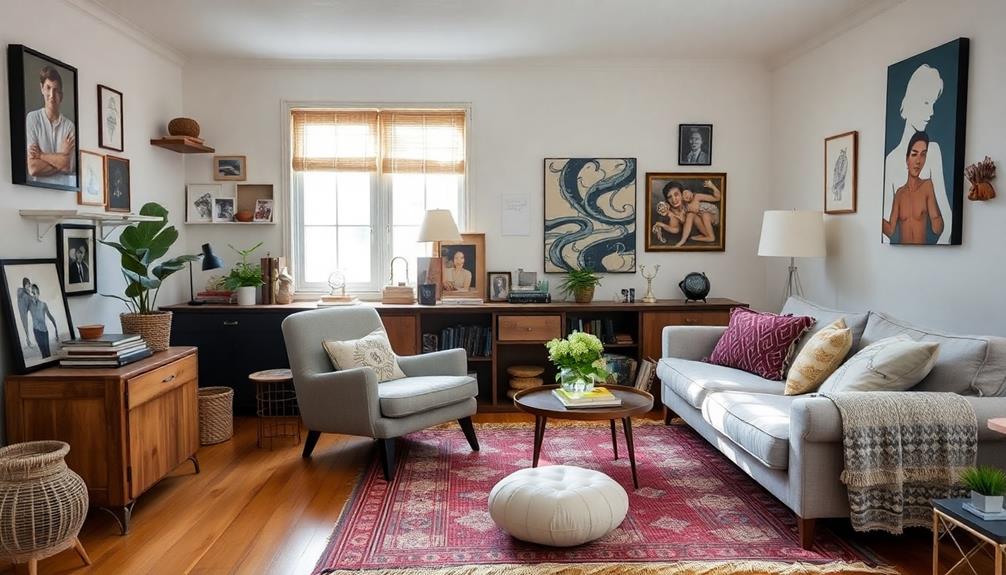
Understanding your personal style is the first step in creating a home that truly reflects who you are. It starts with reflecting on your favorite colors, materials, and overall design inclinations—whether you lean towards modern aesthetics or prefer something more traditional.
For instance, incorporating Indonesian decorative pillows with vibrant colors and intricate patterns can enhance both comfort and style in your living space. Take time to analyze your preferences for vibrant versus simple color palettes; this can greatly guide your decor choices and set the ambiance in your living space.
Next, think about the textures you're drawn to, like silk or reclaimed wood. Understanding these preferences helps you create a tactile experience that resonates with your aesthetic.
Explore various design styles, such as Art Deco or Scandinavian, to discover new elements that might resonate with your taste.
To clarify your vision, create a mood board filled with design inspiration and images that speak to your style. This visual tool will help you see how different elements come together, making it easier to make purchasing decisions that align with your unique sense of style.
Selecting Color Palettes

When selecting a color palette, it's important to understand how different colors affect your mood and the room's atmosphere.
Incorporating elements from traditional Indonesian style home decor can enhance your design by utilizing natural materials and intricate textiles that add depth and character to your space.
You'll want to balance warm and cool tones to create a harmonious space while also choosing textures that enhance your overall design.
Understanding Color Psychology
Choosing the right color palette for your home can greatly influence the mood and atmosphere of your spaces. Color psychology suggests that warm tones, like reds and oranges, can stimulate energy and excitement, while cool hues, such as blues and greens, promote calm and relaxation.
By incorporating elements of Balinese design characteristics into your color choices, you can enhance the natural flow and connection to the environment. By selecting a color scheme that reflects your personal preferences, you can enhance your emotional well-being and create a harmonious environment.
Neutral colors often provide a versatile foundation, allowing you to easily incorporate vibrant accents that align with popular design styles. For example, a neutral backdrop can highlight bold artwork or colorful furnishings, creating a balanced and cohesive look throughout your home.
Additionally, consider how colors affect perceived space size; lighter shades can make a room feel larger, while darker colors create a cozy, intimate atmosphere.
Pairing your color choices with the right materials—like the plush feel of velvet or the rustic charm of reclaimed wood—can further enhance the overall ambiance. By understanding these principles, you'll be well-equipped to choose a color palette that not only beautifies your home but also supports your emotional well-being.
Balancing Warm and Cool
Balancing warm and cool colors in your home can create a dynamic and inviting atmosphere that resonates with your personal style. Warm colors like reds and oranges inject energy, while cool colors such as blues and greens offer tranquility. By thoughtfully selecting your color palette, you can influence the overall mood of each room.
For instance, incorporating elements from coastal color palettes can enhance the breezy feel of a space while still maintaining balance.
Consider using warm accents against a cool backdrop or vice versa. This combination not only generates visual interest but also fosters harmony within the space. For example, a light blue wall can be beautifully complemented with vibrant orange cushions.
Remember, light colors can make a room feel more spacious, while darker shades create an intimate vibe.
Don't forget about neutrals! They can bridge warm and cool tones, allowing for flexibility in your decor choices. An appropriate use of color also impacts light reflection in the room, with warm colors reflecting light and enhancing the ambiance, while cool colors tend to absorb it.
Ultimately, a well-balanced mixture of warm and cool colors can transform your home into a space that feels both lively and serene, perfectly tailored to your lifestyle.
Choosing Textures Wisely
A harmonious color palette isn't just about the hues you select; it's also about the textures you incorporate into your space. Choosing the right textures can create a warm, inviting atmosphere while maintaining a cohesive overall look.
For instance, incorporating elements like a Face Indonesian Decor Mask can add cultural flair and intricate designs to your decor.
Here are three key points to take into account:
- Mix Materials: Combine elements like wood, linen, and jute for a rich, layered feel.
- Enhance Visual Interest: Add textures like velvet or reclaimed wood to prevent a sterile appearance, especially in neutral schemes.
- Evoke Feelings: Soft fabrics can make a cozy environment, while smoother finishes convey modernity.
When selecting textures, think about your home's architectural features. For example, exposed brick or shiplap can add depth to your design.
Balance is vital; too many competing textures can overwhelm a space. Instead, aim for a well-curated selection that enhances your color palette and elevates your design's cohesiveness.
Choosing Textures and Materials
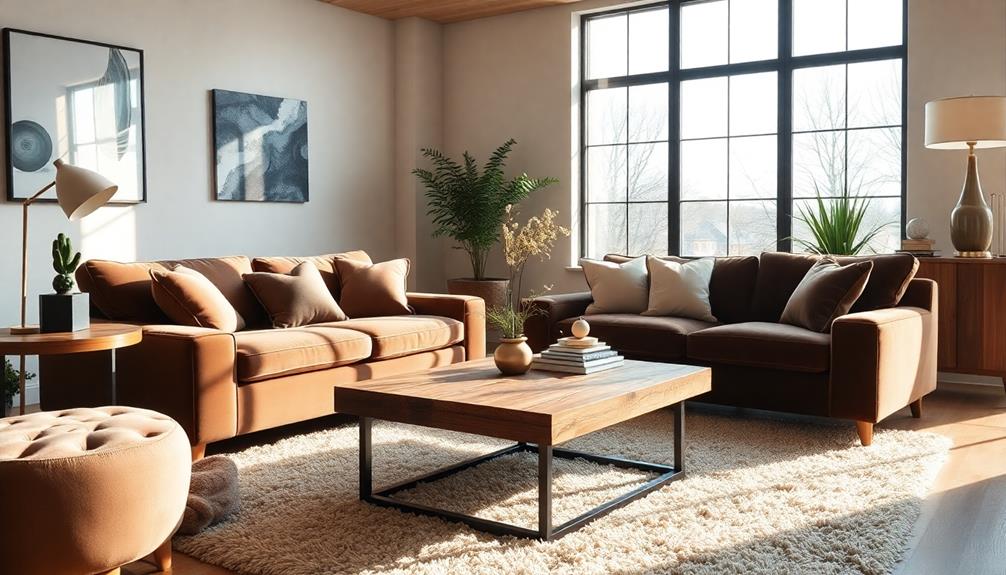
Exploring various textures and materials can greatly enhance the ambiance of your home. When you're selecting textures, prioritize natural materials like wood, linen, and rattan. They add warmth and a tactile experience that elevates your home decor. Mixing different textures, such as soft fabrics alongside rough surfaces, creates visual interest and prevents a sterile appearance in your design style.
Consider how textures can enrich a limited color palette. Pairing neutral tones with varied textures like jute, velvet, and metal can add depth and character. Architectural features, like exposed beams or shiplap, serve as built-in texture elements, enhancing the overall design without needing extra decor.
Additionally, think about the sensory effects of materials. Soft textiles evoke comfort, while sleek metal finishes impart a modern, sophisticated feel.
| Texture Type | Material Example | Sensory Effect |
|---|---|---|
| Soft | Velvet | Comfort |
| Natural | Wood | Warmth |
| Textured | Jute | Rustic charm |
| Sleek | Metal | Modern sophistication |
Popular Interior Design Styles
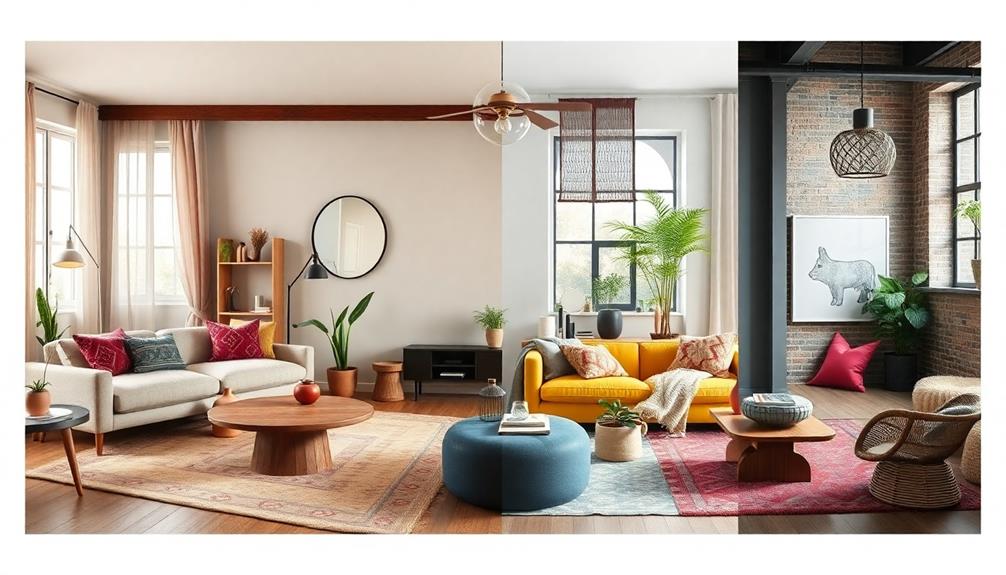
When it comes to popular interior design styles, you'll find a variety of key features that define each one. Traditional designs, for example, often emphasize historical accuracy and regional styles, making them rich in character and depth.
Whether you're drawn to the boldness of Art Deco or the simplicity of Scandinavian design, blending different styles can create a unique look that reflects your personality.
Elements from traditional design can provide a warm, inviting atmosphere, enhancing the overall aesthetic of your home.
Let's explore these styles and how their distinct elements can work together in your home.
Key Design Features
Often, homeowners find themselves drawn to specific interior design styles that resonate with their personal tastes and lifestyles.
Understanding the key features of various styles can greatly enhance your interior decorating journey. For instance, incorporating elements from Southeast Asia Decor can add a rich cultural heritage and vibrant colors to your space.
Here's a quick look at three popular design styles:
- Art Deco: Known for its bold colors and geometric patterns, Art Deco exudes luxury and glamour, reminiscent of the 1920s and 1930s. Look for opulent materials in your furniture and decor to achieve this style.
- Scandinavian: This design style focuses on simplicity and functionality. It emphasizes clean lines, light colors, and natural materials, creating a cozy atmosphere that feels inviting and fresh.
- Mid-Century Modern: Combining minimalist principles with vibrant colors, Mid-Century Modern features furniture with tapered legs and organic shapes. Jewel tones often complement neutral palettes, making your space feel both stylish and dynamic.
Blending Different Styles
Combining different interior design styles can transform your home into a unique reflection of your personality. Blending different styles allows you to create a personalized aesthetic where elements from modern design and traditional styles coexist harmoniously.
For instance, you can mix sleek modern furnishings with rustic farmhouse style elements, adding warmth while maintaining a contemporary feel. This combination creates an inviting atmosphere that feels both cozy and chic. You might also consider incorporating Boho Above Bed Decor for a touch of whimsy and natural elements that enhance the overall vibe.
To successfully blend styles, identify common threads in color palettes, materials, and textures. For example, you might incorporate Scandinavian simplicity with bold shapes from Mid-Century Modern design. This guarantees a cohesive look throughout your home.
Aim for balance by selecting a dominant interior design style to guide your overall design, while allowing accents from other styles to add interest without overwhelming the space.
Mixing Design Elements

Mixing design elements can transform your space into a personalized haven that reflects your unique style. By blending various styles, you can create an inviting atmosphere that feels true to you.
To elevate your interior design, consider incorporating luxury tropical designs that utilize natural materials and vibrant colors. Here are three tips to get started:
- Establish a consistent color palette: Choose a few key colors to tie your mixed elements together. This guarantees visual harmony and cohesion throughout the space.
- Incorporate diverse textures: Pair soft fabrics with raw wood or sleek metals to add depth and interest. Textures can create a dynamic feel while maintaining balance.
- Use statement pieces: A bold artwork or an eclectic rug can anchor your design, serving as a focal point amidst diverse elements. These pieces help unify the overall look.
While mixing design elements, remember to maintain a predominant style. This will prevent your space from feeling cluttered or disjointed.
Practical Considerations for Spaces

When designing your home, practical considerations play a vital role in guaranteeing both comfort and functionality. Effective space planning enhances your home's aesthetics while accommodating daily routines.
For instance, incorporating smart home theater design elements can elevate your entertainment experience, while creating dedicated zones for work, relaxation, and play is necessary, especially if you have children. Prioritizing safe play areas is necessary, so opt for durable, stain-resistant materials in your furniture to withstand wear and tear.
When it comes to your kitchen, functionality is key. Consider the layout, storage options, and ease of movement to create an efficient cooking environment.
Utilize creative storage solutions, like built-in shelves and multifunctional furniture, to maximize limited spaces and keep your areas organized and clutter-free.
Regularly reassessing and updating your design elements can help maintain a fresh and inviting atmosphere. This adaptability allows your space to evolve as your needs and preferences change.
Finding Design Inspiration
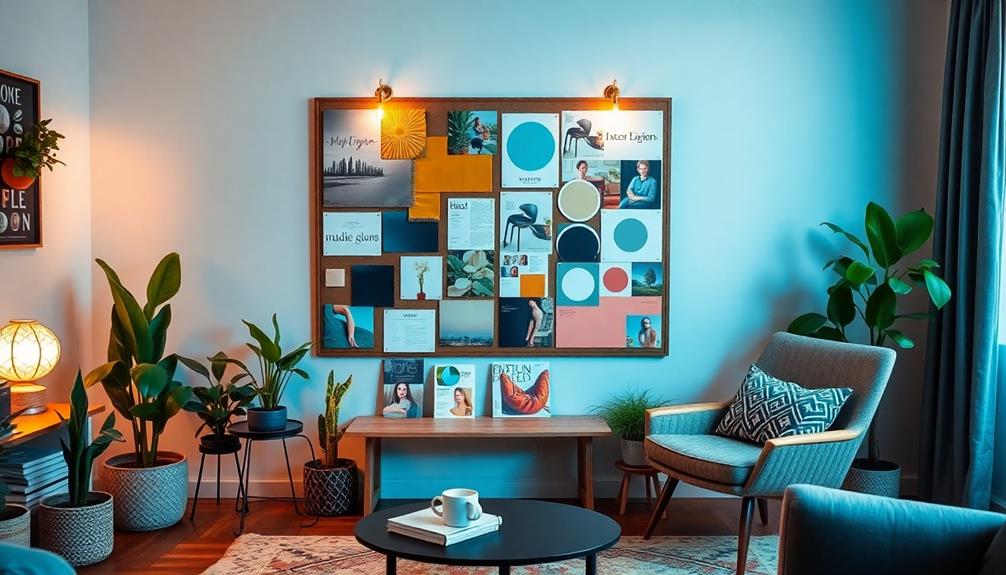
Inspiration for your home's design can come from countless sources, making it exciting to explore various styles and ideas. Here are three effective ways to find the perfect design inspiration for your modern home:
- Online Platforms: Utilize Pinterest and Instagram for a wide range of interior design inspiration. Search for broad terms related to home decor to visualize different styles and elements that catch your eye.
- Create a Mood Board: Use tools like Canva or Pinterest to compile your favorite design images. This helps you organize your thoughts and identify recurring themes and styles that resonate with your personal taste.
- Visit Local Stores: Experience textures and materials firsthand by visiting home decor stores. Engaging with sales staff can provide expert insights, giving you a better understanding of what works in your space.
Once you've gathered inspiration, analyze your pinned images and narrow them down to 25-30 favorites.
Focus on consistent design elements, colors, and furniture types that appeal to you. Exploring popular styles like Scandinavian, Mid-Century Modern, and Coastal can also guide you in creating a cohesive aesthetic for your home.
Collaborating With Designers

Collaborating with a designer can transform your home into a reflection of your unique style and needs. When you work with a designer, you gain access to professional expertise and fresh ideas that enhance your vision for your space while helping you avoid costly design mistakes.
Establishing clear communication about your expectations and preferences is essential. This guarantees the final outcome aligns seamlessly with your personal style.
A well-chosen designer can navigate the complexities of space planning, guaranteeing that functionality complements aesthetic appeal, especially in challenging layouts. They often have access to exclusive resources, materials, and furnishings that elevate your design aesthetic beyond what's available to the general public.
Engaging in a collaborative process fosters brainstorming and feedback, leading to innovative solutions tailored to your lifestyle. So, don't hesitate to share your thoughts and ideas during the design process.
Finalizing Your Design Choices

Finalizing your design choices is an essential step in creating a space that reflects your personality and meets your needs. To guarantee that you're making the right decisions, consider these three key steps:
- Evaluate your emotional responses: Pay attention to how different designs make you feel. Choose elements that evoke excitement or joy; this will lead to long-term satisfaction with your choices.
- Research design styles: Dive deep into various interior design styles. Understand their characteristics and see how they resonate with your personal aesthetics. This knowledge will guide you in selecting elements that truly reflect your taste.
- Create a mood board: Compile your favorite design elements into a mood board. Include images of desired furniture, decor, and colors to visualize the harmony of your selections.
As you're finalizing your design choices, document standout features that inspire you. This will help you maintain clarity and guide future decisions.
Frequently Asked Questions
How to Choose Interior Decor?
To choose interior decor, start by identifying your style on platforms like Pinterest. Consider your space's functionality, select a cohesive color palette, invest in quality pieces, and regularly reassess your choices for a vibrant environment.
How Do I Decide How Do You Decorate My House?
Decorating your house is like painting a canvas. Start by exploring your style, assess room functionality, choose a cohesive color palette, invest in quality essentials, and refresh regularly to keep your masterpiece vibrant and inviting.
How to Choose a Theme for a Home Interior?
To choose a theme for your home interior, think about your personal style, gather inspiration through mood boards, research popular designs, and consider the ambiance and functionality you want to create in your space.
How Do I Choose an Interior Design Concept?
To choose an interior design concept, identify your personal preferences, create a mood board for inspiration, research various styles, and analyze your collected images to find consistent elements that resonate with your aesthetic and lifestyle needs.
Conclusion
Choosing the perfect interior decor for your home can transform your space and reflect your unique personality. Did you know that 80% of homeowners feel more satisfied with their lives when their living spaces are aesthetically pleasing? By understanding your personal style, selecting the right colors and textures, and mixing design elements, you can create a harmonious environment. Don't hesitate to seek inspiration and collaborate with designers to finalize your vision. Your dream home is within reach! Investing in high-quality furniture and statement pieces can elevate your space and bring your vision to life. Consider incorporating elements of timeless elegance and modern sophistication to achieve effortlessly chic interior decor. By focusing on creating a balance between functionality and style, you can curate a space that not only looks beautiful but also suits your lifestyle. With the right attention to detail and a curated selection of decor items, you can make your dream home a reality. Here are a few interior decor tips to keep in mind as you work to create your dream home. First, don’t be afraid to experiment with different styles and mix and match pieces to create a personalized and unique look. Second, consider the flow and functionality of each room when choosing decor elements, ensuring that your space is not only beautiful but also practical. Lastly, pay attention to lighting and how it can enhance the ambiance of each room, whether through natural light, strategically placed lamps, or statement light fixtures. Remember, creating the perfect interior decor is about expressing your individuality and making your home a reflection of who you are.
Home Decor
How Batik Symbolism Can Create Harmony and Balance in Your Home
See how Batik symbolism can enhance your home’s harmony and balance, and discover which patterns might resonate with your personal space.

Batik symbolism can transform your home by infusing it with deep meaning and a sense of balance. You can use patterns like the Kawung, which promotes serenity, or the Ceplok, fostering unity and emotional warmth. Incorporating Batik textiles in your decor—like cushions, wall art, or tablecloths—creates a harmonious atmosphere that enhances visual appeal. These vibrant designs not only beautify your space but also serve as cultural reminders that inspire conversation. By strategically placing Batik pieces, you actively cultivate a nurturing environment. Want to explore how to harmonize your home even further? You might find more valuable insights waiting for you.
Key Takeaways
- Batik motifs like Kawung and Ceplok symbolize balance and unity, fostering a serene and harmonious atmosphere in your home.
- Incorporating Batik textiles in decor, such as curtains and pillow covers, enhances warmth and visual balance, enriching your living spaces.
- Unique Batik patterns tell cultural stories, promoting discussions and adding depth to your home environment while reflecting values of harmony and balance.
- Strategic placement of vibrant Batik pieces can transform the ambiance, inviting positive energy and a sense of nurturing throughout the home.
- Batik art enhances aesthetics, merging traditional craftsmanship with modern design, resulting in a cohesive and inviting living environment.
The Essence of Batik Symbolism

Batik symbolism is more than just beautiful patterns; it's a way to infuse your home with meaning and harmony. By incorporating Batik motifs like the Kawung, you invite balance into your living space. This particular design symbolizes equilibrium, promoting a serene atmosphere that enhances your home decor.
Similarly, the Ceplok pattern represents unity and interconnectedness, reflecting the bonds of family and community. Using this motif can elevate the emotional ambiance of your interior design, creating a sense of togetherness. Additionally, the vibrant colors and intricate patterns found in Indonesian decorative pillows can complement Batik textiles wonderfully, further enriching your home.
Batik's Cakar Ayam design signifies diligence and prosperity, introducing positive energy flow that contributes to a harmonious home environment. When you choose Batik textiles, such as curtains or cushion covers, you're not just adding aesthetic appeal; you're also tapping into rich cultural traditions that foster tranquility.
Furthermore, incorporating Batik art pieces serves as a conversation starter and a reminder of the values of harmony and balance inherent in this tradition. By thoughtfully integrating these symbols into your home, you can create a space that resonates with peace and cultural depth, making your living area not just beautiful, but meaningful.
Historical Background of Batik
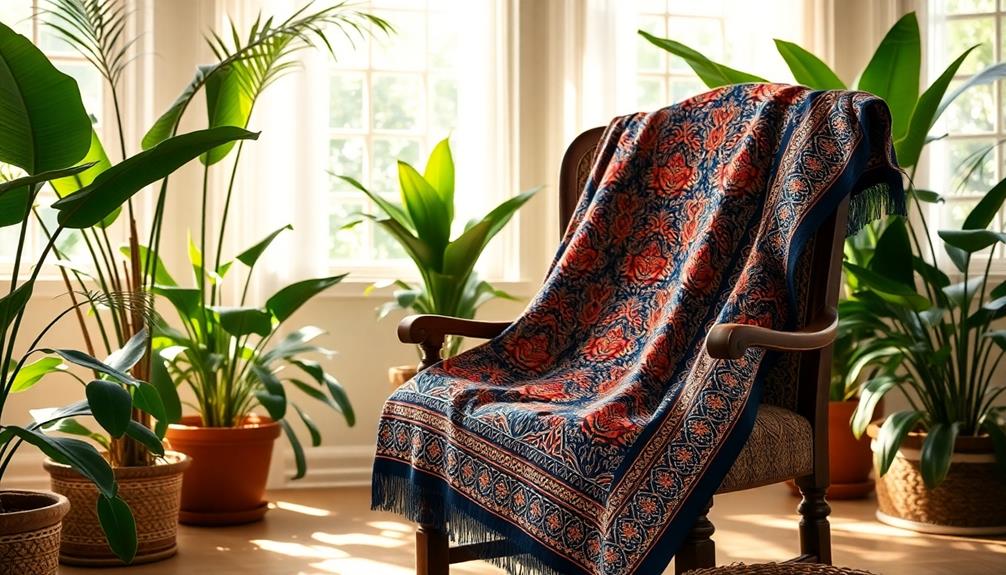
The rich cultural significance of Batik is deeply rooted in its historical background, which traces back to the Indonesian island of Java. This ancient textile art form originated as early as the 4th or 5th century AD, showcasing the skillful use of the wax-resist dyeing process.
The term "batik" derives from a Javanese word meaning "to dot" or "to stipple," reflecting the intricate patterns that characterize this craft. Batik, much like the intricate designs of Indonesian decor masks, holds a special place in Indonesia's cultural heritage, and its motifs often convey deeper meanings tied to traditions and beliefs.
In 2009, UNESCO recognized Batik as a Masterpiece of Oral and Intangible Heritage, highlighting its global importance.
Here are some key aspects of Batik's historical significance:
- Cultural Traditions: Specific designs are reserved for holidays and ceremonies.
- Symbol of Nobility: Certain patterns signify social status and nobility.
- Generational Legacy: The art has evolved through family traditions, showcasing vibrant cultural heritage.
Key Batik Patterns and Their Meanings

When decorating your home, incorporating key Batik patterns can greatly enhance the ambiance and meaning of your space. Each pattern carries unique symbolism that can foster harmony and balance in your environment.
The Kawung pattern, with its interlocking circles or squares, symbolizes balance and harmony, making it ideal for evoking tranquility. Additionally, integrating traditional art elements, such as Indonesian decor masks, can further enrich the cultural storytelling in your home, adding depth to your decor traditional artistry in masks.
The Ceplok pattern features bold central motifs that embody unity and adaptability, perfect for creating a cohesive aesthetic in your living areas.
Meanwhile, the Nitik pattern, with its tiny dots arranged in geometric designs, represents fertility and growth, encouraging positive energy and an uplifting atmosphere.
If you're looking for strength, consider the Parang pattern, characterized by diagonal lines that symbolize power and resilience, instilling stability within your home.
Incorporating Batik in Home Decor

Integrating Batik into your home decor not only enhances visual appeal but also brings rich cultural significance to your space. You can easily incorporate batik motifs and vibrant colors into various elements of your home, creating an inviting atmosphere that reflects traditional artistry.
Additionally, the intricate designs of Indonesian decor masks can complement batik pieces, further enriching your home's aesthetic.
- Batik fabric for curtains and pillow covers: These pieces add warmth and intricate patterns, elevating your living space.
- Batik tablecloths or runners: They create a unique dining experience, infusing meals with cultural richness while promoting harmony and prosperity among family members.
- Batik-inspired wall art: Framed pieces or canvas prints act as eye-catching focal points, celebrating heritage and enhancing the overall decor.
Creating Balance With Batik Textiles
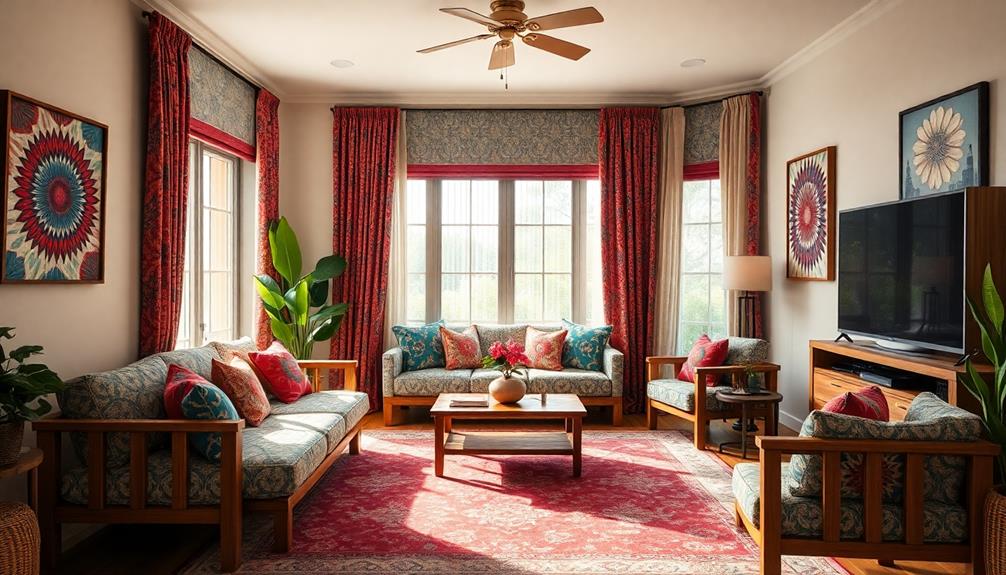
Batik textiles offer a unique way to bring harmony and balance into your home. By incorporating these stunning fabrics, you can create an inviting ambiance that resonates with unity and stability. Geometric patterns like the Kawung design symbolize balance, while motifs such as the Ceplok pattern enhance feelings of calm in shared spaces.
Here's a quick overview of how different batik designs can impact your decor:
| Design | Symbolism | Effect on Space |
|---|---|---|
| Kawung | Harmony | Serene atmosphere |
| Ceplok | Stability | Enhanced unity and calm |
| Mega Mendung | Life-giving rains | Revitalizing and nurturing ambiance |
| Vibrant Colors | Cultural artistry | Infuses positive energy |
| Geometric Patterns | Visual balance | Cohesive decor aesthetic |
Utilizing vibrant batik colors and designs in items like curtains or pillow covers can infuse your environment with cultural artistry. Strategically placing these batik pieces throughout your home cultivates a visually balanced aesthetic, allowing you to enjoy the intricate stories and meanings behind each design. Embrace the beauty of batik textiles to enhance your space's harmony and stability.
Batik as Cultural Storytelling

Incorporating batik textiles into your home isn't just about aesthetics; it's a way to weave cultural narratives into your living space.
Batik patterns serve as a medium for storytelling, reflecting deep cultural heritage and societal values. Each design conveys themes of harmony and balance, enriching your environment with symbolic meanings.
Additionally, using natural materials in conjunction with batik can enhance the overall ambiance, creating a space that resonates with traditional Indonesian style.
Consider these impactful batik motifs:
- Kawung pattern: Featuring interlocking circles, it symbolizes the eternal cycle of life and hope for enduring balance.
- Nitik pattern: Representing fertility and growth, it inspires a nurturing atmosphere, enhancing family harmony.
- Ceplok pattern: With its geometrical shapes, it embodies the essence of unity, resonating with togetherness in your home decor.
Harmonizing Spaces With Color
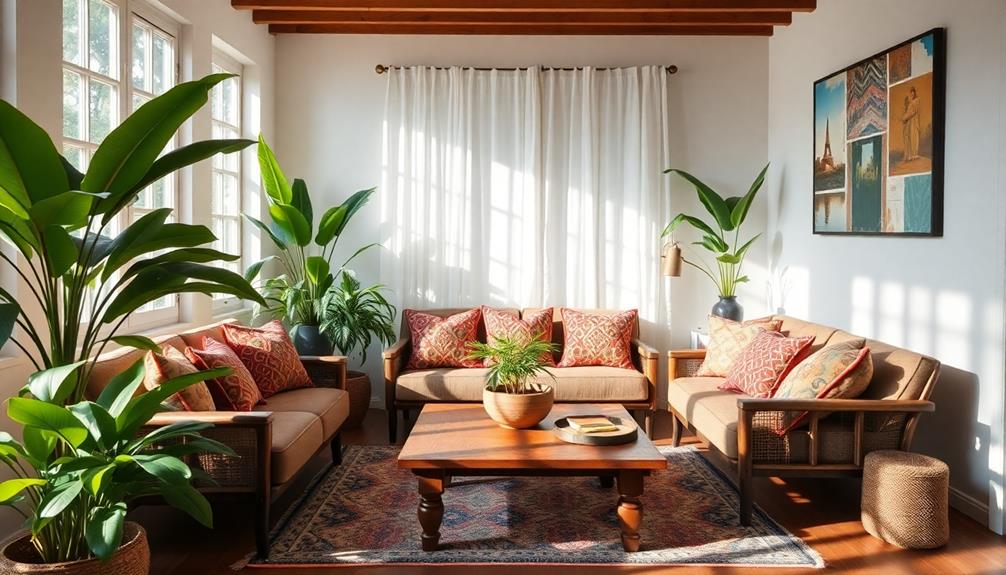
Harmonizing your living space with color can transform the atmosphere and evoke a sense of warmth and positivity. By incorporating batik fabric into your home decor, you enhance the color palette while embracing intricate patterns that invite balance and harmony. The Kawung pattern, with its interlocking circles, symbolizes unity, making it perfect for cushions or wall hangings.
To visualize how colors and patterns can work together, consider this layout:
| Batik Motif | Color Palette | Decorative Element |
|---|---|---|
| Kawung | Earthy tones | Cushion covers |
| Mega Mendung | Blues and greens | Tablecloth |
| Floral patterns | Warm vibrant hues | Curtains |
Using batik-inspired curtains or tablecloths creates focal points that not only showcase unique designs but also stir conversations. The Mega Mendung pattern represents life-giving rains, instilling tranquility and a connection to nature. By integrating batik motifs into your decor, you embrace a rich cultural heritage that resonates with values of unity and balance, fostering a harmonious atmosphere throughout your home.
Modern Applications of Batik
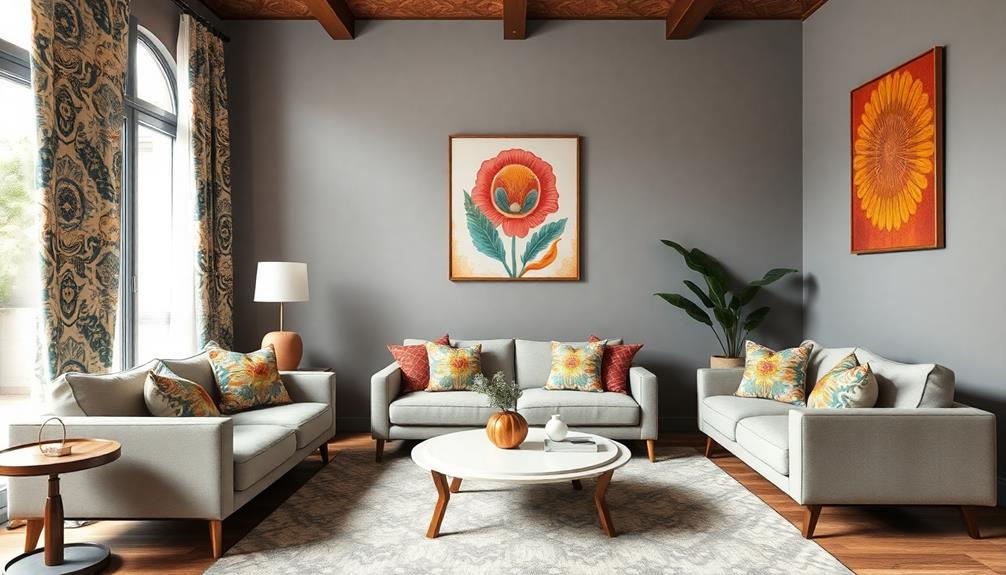
Home decor can effortlessly blend tradition with modernity when you embrace batik's vibrant patterns and colors. By incorporating batik fabric into your living space, you invite a touch of cultural artistry that enhances the overall aesthetic.
These traditional patterns can transform ordinary items into stunning focal points, creating a warm and harmonious atmosphere. Additionally, the use of natural materials and sustainable practices in designs, similar to luxury tropical design aesthetics, aligns beautifully with the ethos of batik artistry.
Consider these modern applications of batik:
- Batik quilts: Serve as both functional items and artistic statement pieces, showcasing unique designs and textures.
- Upholstery: Contemporary designers are using batik for furniture upholstery, merging traditional craftsmanship with modern design elements for a stylish finish.
- Wall art: Batik can also be used creatively in wall art, providing an eye-catching blend of color and cultural heritage.
The versatility of batik allows you to explore various creative projects, from curtains and pillow covers to tablecloths. Each piece not only adds beauty but also honors the rich traditions behind this exquisite fabric.
Frequently Asked Questions
What Does Batik Symbolize?
Batik symbolizes cultural heritage and identity. Each pattern conveys unique meanings, like strength, harmony, and divine blessings. By understanding these symbols, you can appreciate their significance and enhance your living space's character and ambiance.
How Is Batik Used in Everyday Life?
How do you express your culture daily? You use batik in your clothing, home decor, and accessories, embracing its vibrant patterns and rich heritage, transforming ordinary spaces into reflections of your identity and creativity.
What Is the Importance of Batik?
Batik's importance lies in its rich cultural significance and storytelling. You appreciate its intricate designs that reflect heritage and philosophy, connecting you to a broader community while enhancing your living space with beauty and meaning.
What Makes Batik Special?
Batik's special because it blends intricate artistry with deep cultural meanings. Each design you see tells a story, reflecting values like balance and strength. You'll appreciate its vibrant colors and rich heritage adorning your space.
Conclusion
By embracing batik symbolism in your home, you're not just decorating; you're infusing your space with rich cultural narratives and meaningful patterns. You might think it's too bold for your decor style, but batik's versatility allows it to blend beautifully with various aesthetics. Whether you choose vibrant colors or subtle hues, batik can create harmony and balance, turning your home into a sanctuary that reflects both your personality and a deep appreciation for artistic heritage.
Home Decor
Discover the Batik Patterns That Will Add Depth to Any Space
Open your eyes to the vibrant world of batik patterns that can transform your space into a masterpiece—discover the possibilities that await!
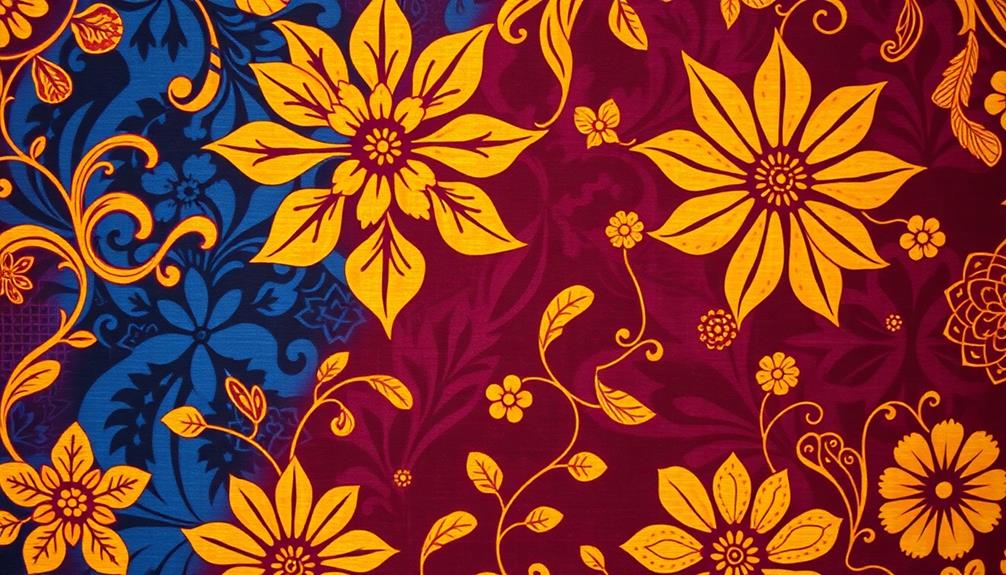
Batik patterns are a fantastic way to infuse vibrancy and depth into your space. Originating from Javanese culture, these intricate designs feature rich colors and unique motifs, each with its significance. You'll find styles like Batik Tulis, hand-drawn for a personal touch, or Batik Cap, stamped for ease. Whether you choose decorative cushions, bold wall art, or vibrant table runners, batik adds character and a sense of history to your decor. This creative flexibility complements various design styles while offering a unique, artistic flair. Stick around to explore even more stylish batik options that can transform your home!
Key Takeaways
- Batik patterns, rooted in Javanese culture, showcase intricate artistry that adds historical richness to any decor.
- Vibrant designs, such as the Color Flow and Juxtaposition quilts, create stunning visual contrasts in living spaces.
- Unique, handmade batik pieces serve as focal points, enhancing artistic expression and personalization in interior design.
- Seasonal batik patterns, like Snow Crystals, introduce festive themes while showcasing craftsmanship, perfect for holiday decor.
- Incorporating batik textiles elevates home decor, providing a personal touch and fostering cultural appreciation in various settings.
Understanding Batik Patterns

When you immerse yourself in the world of batik patterns, you uncover a rich tapestry of artistry and culture. Traditional batik originated from the Javanese tradition, where artisans employ intricate batik techniques to create stunning designs. This craft involves applying hot wax onto fabric, which resists dye, resulting in vibrant, unique patterns that tell stories through their motifs.
Additionally, batik patterns often share similarities with traditional Indonesian decor masks, as both celebrate the rich cultural heritage of Indonesia through vibrant artistry and storytelling traditional artistry.
You'll find different types of batik, such as Batik Tulis, which is hand-drawn, and Batik Cap, which is stamped. Each method offers varying levels of detail, showcasing the skill of the maker. The batik motifs you encounter often carry significant cultural meanings; for instance, certain colors and designs can denote social status or convey specific messages within Indonesian culture.
When you consider incorporating batik into your home decor or fashion choices, you're not just adding beauty; you're also embracing a piece of history. The versatility of batik allows it to enhance any space, blending historical richness with modern artistic expression.
Seaside and Coastal Inspirations

Batik patterns inspired by the seaside can transform your space into a tranquil coastal retreat. Imagine the soothing blues and greens reminiscent of ocean waves dancing across your walls or furniture.
Incorporating Indonesian Decorative Pillows with vibrant batik designs can further enhance the coastal vibe, adding comfort and cultural heritage to your decor. Batik fabrics featuring designs like the Seaside Steps quilt, with its Courthouse Steps blocks in fresh, cool tones, evoke that nautical feel perfect for coastal decor.
Another stunning option is the Batak Ocean Waves quilt, which incorporates gold triangles that create playful pinwheels within the Ocean Waves blocks. The combination of blue and cream batiks adds a sense of movement, making your space feel alive and inviting.
For a more modern touch, the Beachy Waves quilt showcases a bargello style that mimics actual ocean waves, using a palette of sea glass colors. This creates a soothing ambiance ideal for beach houses or any coastal-inspired room.
All these batik designs not only celebrate the beauty of traditional motifs but also bring a revitalizing atmosphere into your living spaces.
Plus, they're available as free downloads, allowing you to easily enhance your home decor with seaside charm.
Seasonal and Holiday Themes
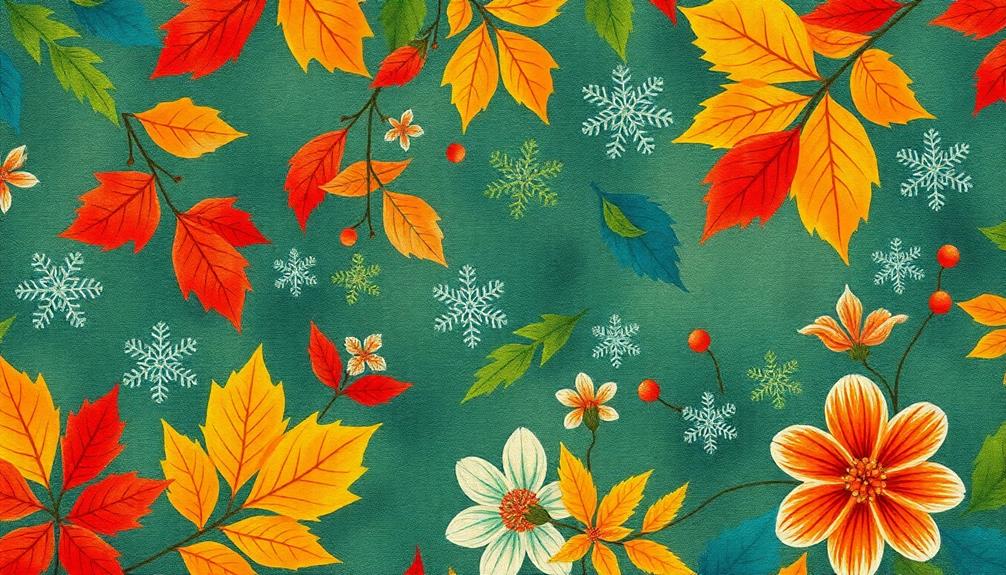
Celebration comes alive with seasonal and holiday-themed batik patterns that bring joy and warmth to any space. These patterns, like Snow Crystals, capture the essence of winter with cool colors, perfect for seasonal decor and striking wall hangings. The Patriotic Patches pattern features vibrant red squares alongside serene blue and white strips, making it an ideal choice for patriotic celebrations.
Incorporating seasonal batik designs into your home not only adds a festive touch but also showcases the unique artistry and craftsmanship of batik textiles. Many seasonal batik quilts come with free patterns available for download, allowing you to easily integrate these stunning designs into your holiday decor.
| Pattern Name | Best For |
|---|---|
| Snow Crystals | Winter decor |
| Patriotic Patches | Independence Day |
| Seasonal Quilts | Year-round celebrations |
Using batik fabrics enhances the visual appeal, creating a vibrant atmosphere during celebrations. Whether you're hosting a gathering or simply want to add a touch of warmth, these seasonal batik patterns are sure to make your space feel festive and inviting.
Vibrant and Colorful Designs
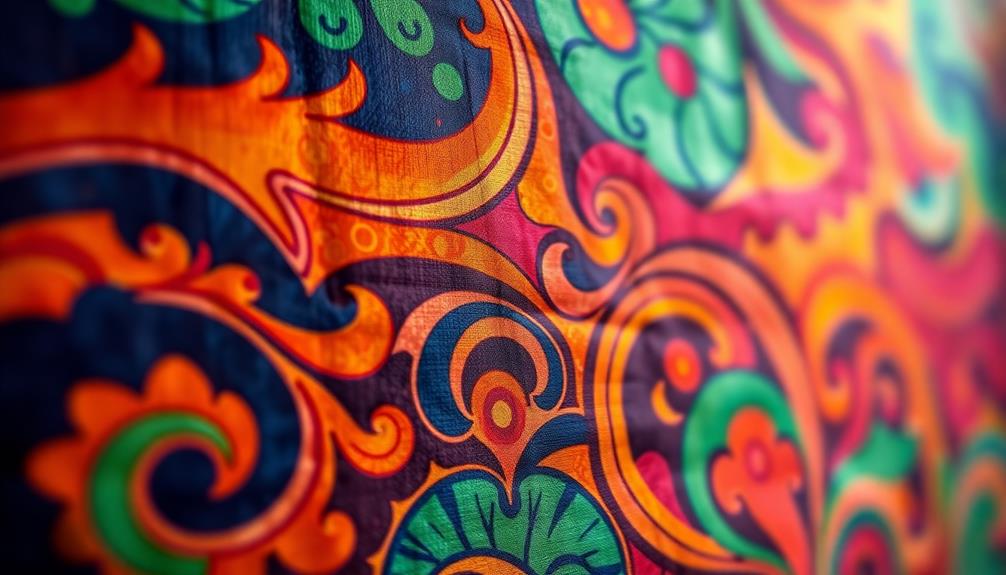
Amidst the world of interior design, vibrant and colorful batik patterns effortlessly alter any space into a visual feast. You'll find that traditional Indonesian batik, with its rich history, showcases vibrant designs that breathe life into your home.
Consider the Juxtaposition quilt, featuring jewel tones that create stunning contrasts, perfect for cozy settings. Or take a look at Color Flow, which presents an enchanting rainbow effect, shifting from hot to cool colors set against a bold black background—ideal for striking wall decor. These batik patterns, much like the unique artistic expressions found in Indonesian decor masks, highlight the beauty of traditional craftsmanship.
The Batik Jewels Throw offers large triangle-square units in elegant jewel tones, creating a diagonal-stripe effect that enhances any living space. Each of these vibrant designs not only highlights the intricate craftsmanship of batik textile art but also invites you to explore your creativity.
Free quilt patterns are available for download, making it easier than ever to incorporate these modern motifs into your decor.
With these colorful batik patterns, your space will reflect both style and personality, turning it into a warm and inviting haven that celebrates the beauty of batik.
Unique and Artistic Patterns
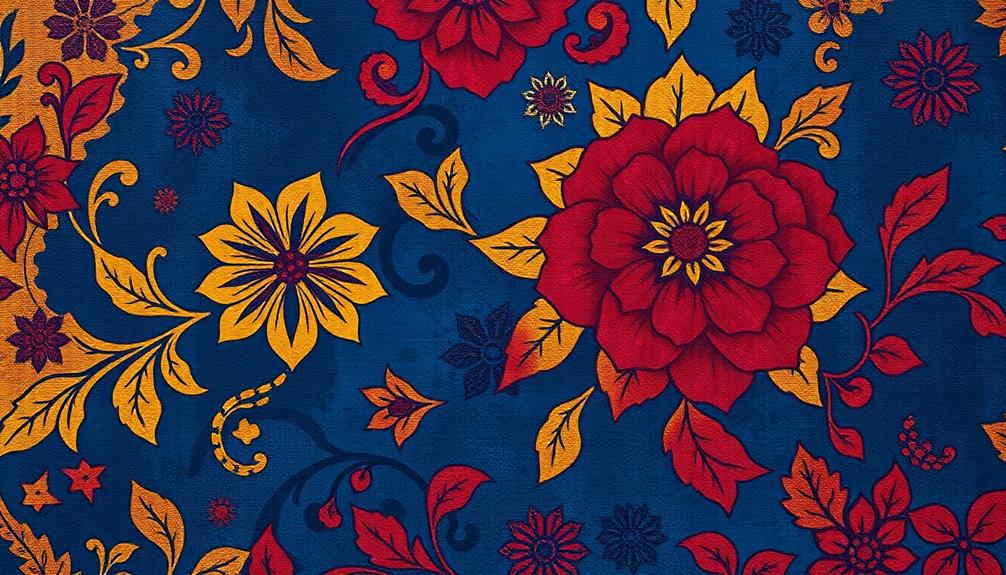
When you explore unique batik patterns, you'll discover a world of artistic expression waiting to be released. Each design, inspired by various themes and styles, invites you to interpret and personalize it in your own way.
These patterns not only enhance the aesthetic appeal of your space but also reflect the rich cultural heritage of Indonesia, much like the intricately designed Indonesian decor masks that tell stories through their craftsmanship.
Whether it's the intricate Tile Style or the subtle Wild Triangle-Squares, these patterns transform any space into a creative haven.
Artistic Expression in Batik
Batik patterns offer a vibrant canvas for artistic expression, inviting you to explore unique designs that transform any space. You can experience the beauty of batik cloth through various batik creations, each reflecting the intricate techniques of ancient Javanese artistry.
Incorporating batik into your decor aligns beautifully with traditional Indonesian style home decor, emphasizing harmony with nature and showcasing local culture. Using batik allows you to showcase your creativity, whether through a complex batik throw inspired by tiled auditorium floors or a subtle Wild Triangle-Squares wall hanging that captures a unique watercolor effect.
The Batik Jewels Throw demonstrates elegance with large triangle-square units that create a striking diagonal-stripe effect, perfect for cozy living areas. Each hand-drawn batik piece emphasizes vibrant colors and detailed patterns, encouraging you to express your artistry and elevate your decor.
The intricate wax-resist dyeing techniques contribute to the uniqueness of each pattern, making them ideal for those seeking depth and character.
Unique Design Inspirations
Adding batik to your decor opens up a world of unique design inspirations that can elevate your space. Consider the Tile Style batik throw, inspired by tiled auditorium floors, which showcases intricate patterns and encourages your artistic expression. This piece, with its complex designs, can be an eye-catching addition to your living room or bedroom, creating a stunning batik wall.
Additionally, incorporating traditional motifs and patterns can enhance the cultural significance of your decor.
For those drawn to nature, the Wild Triangle-Squares Wall Hanging offers a safari theme with subtle, watercolor effects. The limited contrast in batiks allows the rich dark blue hues to blend beautifully, making it perfect for a serene and inviting atmosphere.
Both of these unique batik designs not only serve as focal points but also enhance the visual appeal of your interiors. The batik industry produces an array of options, from vibrant silk batik to more muted pieces, allowing you to find the perfect match for your style.
Incorporating Batik in Home Decor

Transforming your home into a vibrant sanctuary can be easily achieved through the incorporation of batik fabrics. These textiles, renowned for their intricate designs and vibrant colors, can elevate your home decor in various ways.
Batik's unique patterns can complement the calming earth tones and natural materials often seen in Balinese interior design concepts. You can effortlessly incorporate batik, whether it's Batik Tulis or stamped batik, to create a unique artistic atmosphere.
Here are some creative ideas for using batik in your space:
- Cushions and Throws: Add colorful batik cushions and throws to your living room for an instant pop of color.
- Wall Art: Hang framed batik panels as bold statement pieces that reflect cultural significance and craftsmanship.
- Table Runners: Use batik table runners or placemats to enhance your dining experience, bringing warmth and style to your meals.
The versatility of batik allows it to blend seamlessly into various design styles, from traditional to modern.
Plus, the handmade nature of these fabrics guarantees that each piece is unique, giving your home decor an authentic and personal touch that mass-produced items simply can't match.
Embrace batik and watch your space come alive!
Frequently Asked Questions
What Are the Patterns of Batik?
Batik patterns vary widely, including intricate hand-drawn designs, stamped motifs, and painted styles. Each offers unique artistic expressions, reflecting cultural significance and vibrant colors influenced by regional traditions and modern interpretations. You'll appreciate their beauty!
What Are the 5 Major Types of Batik Design?
When exploring batik designs, you'll encounter five major types: Batik Tulis, Batik Cap, Batik Lukis, Batik Pesisir, and Batik Belanda. Each offers unique techniques and styles, showcasing Indonesia's rich cultural heritage and artistic expressions.
What Is the Most Famous Batik Pattern?
Did you know that the "Kawung" pattern is one of the most famous batik designs? Its geometric coconut symbol holds deep cultural significance in Javanese society, representing both beauty and tradition. You'll love its intricate elegance!
What Are the Three Main Elements of Batik Pattern?
The three main elements of batik patterns are the base fabric, wax application, and dye baths. You'll see how these components work together to create vibrant, intricate designs that reflect cultural significance and artistic expression.
Conclusion
Incorporating batik patterns into your home decor is like adding a splash of color to a black-and-white canvas. These vibrant designs can transform any space, imbuing it with personality and warmth. Whether you opt for seaside motifs, seasonal themes, or unique artistic prints, you'll create an inviting atmosphere that reflects your style. So go ahead, embrace the beauty of batik and watch your home come alive with depth and character!
Home Decor
Batik: The Cultural Design Element You’re Missing in Your Home
Not only does Batik enhance your home decor, but it also connects you to a rich cultural narrative waiting to be explored.

Batik isn't just a beautiful textile; it's a piece of rich cultural heritage you're missing in your home. Originating from Indonesia, Batik features vibrant colors and intricate patterns that tell stories of history and symbolism. By incorporating items like cushion covers or wall art, you add depth and character to your space. The Phoenix motif, for instance, represents interdependence, while other designs reflect themes of regeneration and environmental balance. Plus, using Batik supports local artisans and sustainable practices. Want to discover how to seamlessly integrate these stunning designs into your decor? There's so much more waiting for you.
Key Takeaways
- Batik textiles feature vibrant colors and intricate patterns, adding a unique cultural touch to your home decor.
- Incorporating Batik items like cushion covers and wall hangings creates a narrative that reflects Indonesian heritage.
- Each Batik motif carries rich symbolism, offering deeper meaning beyond mere decoration in your living space.
- Supporting local artisans through Batik promotes sustainable practices in the textile industry while celebrating artistic expression.
- Modern Batik designs blend traditional artistry with contemporary aesthetics, appealing to diverse home decor styles.
Historical Significance of Batik

Batik, with its roots deeply embedded in Indonesia's rich history, stands as not just a textile art but a symbol of cultural identity. The historical significance of Batik is profound, tracing back to the Hindu-Buddhist Majapahit Empire, where it first flourished. This traditional Javanese art form evolved during the 16th century, integrating Islamic influences and showcasing the diverse cultural heritage of Indonesia.
Similar to traditional artistry in Indonesian decor masks, Batik textiles reflect the vibrancy and complexity of local stories and customs.
As you explore Batik, you'll notice how its textiles reflect various historical intersections, blending motifs from Hindu, Buddhist, Chinese, Arab, European, Japanese, and even African cultures. Each pattern tells a story, serving as a historical record that captures the essence of Indonesian life and traditions.
The shift from natural plant dyes to synthetic dyes in the 1800s marked a significant evolution, broadening the color palette available for artisans and enhancing the durability of these intricate designs.
Batik isn't just decorative; it symbolizes philosophical beliefs and social status, playing an essential role in formal occasions and daily wear across Indonesian society.
Through its rich history, Batik remains a reflection of the enduring cultural identity of the Indonesian people.
Understanding Batik Motifs
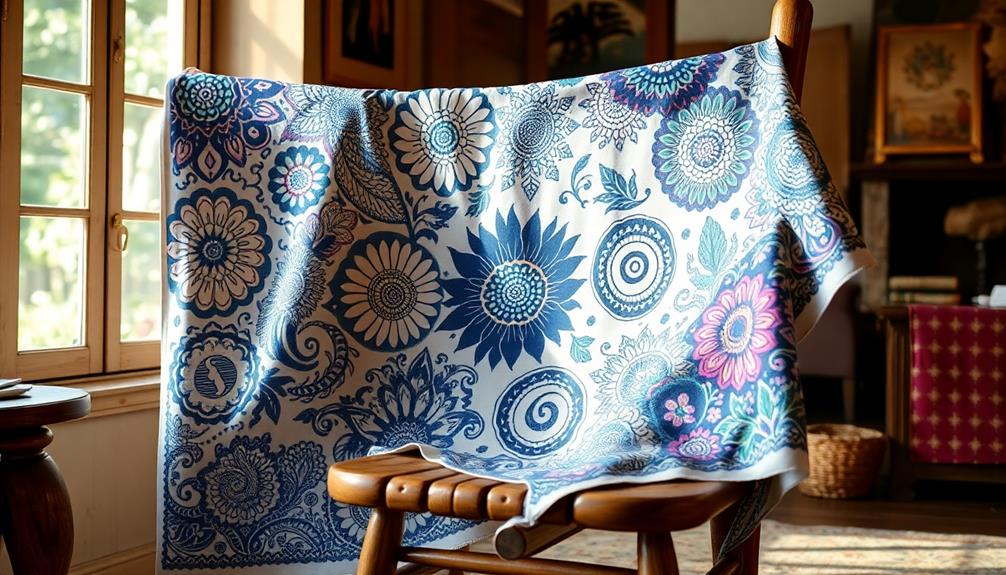
The intricate world of Batik motifs offers a fascinating glimpse into Indonesia's cultural tapestry, where each design serves a purpose beyond mere decoration. Understanding Batik means appreciating the rich symbolism woven into every pattern.
For instance, the Javanese Batik design of the Phoenix Lung-lungan represents interdependence and mutual support, reflecting deep social values. The Kawung motif, with its intersecting squares and circles, historically signified prestige, reserved for royalty, illustrating the cultural hierarchy in Javanese society. Additionally, many Batik patterns, much like the Indonesian decor masks, showcase intricate designs that celebrate traditional craftsmanship.
Furthermore, non-geometric patterns often symbolize regeneration and fertility, showcasing diverse flora and fauna that carry spiritual significance. These motifs connect the wearer to their cultural heritage, transforming them from simple decorative elements into powerful narrative tools.
Take the Udan Liris motif, translating to "light rain," which features diagonal rows of narrow bands symbolizing natural phenomena. This highlights how Batik art can reflect environmental themes as well.
Batik Production Techniques

Understanding the artistry behind Batik motifs naturally leads to exploring the various production techniques that bring these designs to life. The three main Batik production techniques are Batik Tulis, Batik Cap, and Batik Cetak. Each method showcases the cultural heritage of Batik while varying in quality and artistic value.
| Technique | Description |
|---|---|
| Batik Tulis | Hand-drawn designs using a canting tool and wax, allowing for intricate designs that can take months. |
| Batik Cap | Utilizes copper stamps for quicker wax application, maintaining artistic value with efficient production. |
| Batik Cetak | Printed textiles that are more accessible but sacrifice some traditional craftsmanship. |
| Natural Dyes | Traditionally derived from plants like Indigofera and Soga tree, offering rich, vibrant colors. |
While Batik Tulis is often regarded as the highest quality due to the skill involved, Batik Cap and Batik Cetak offer their own unique appeal. Embracing these Batik production techniques not only enhances your home decor but also celebrates the intricate designs and artistic value that reflect a rich cultural heritage.
Modern Interpretations of Batik
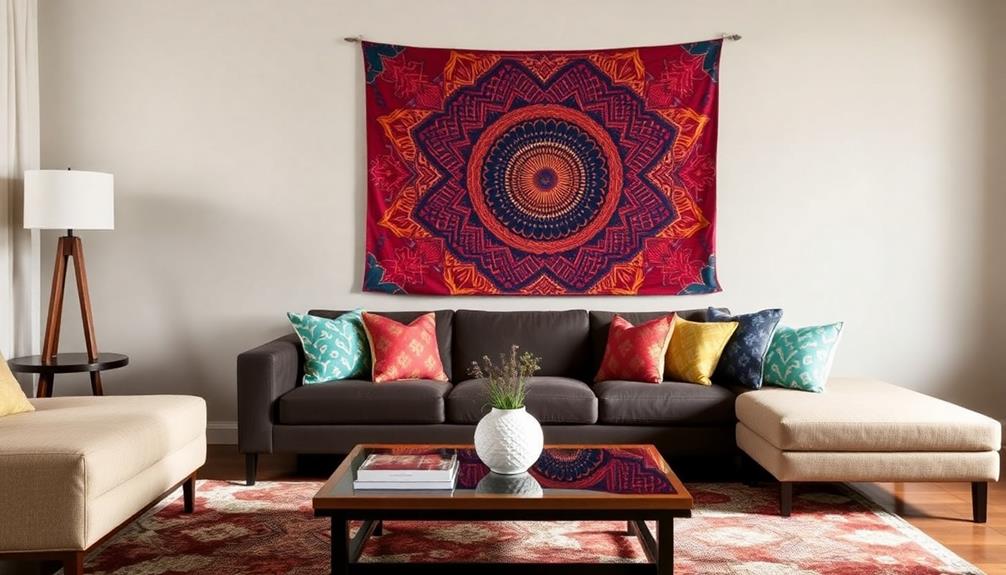
Modern interpretations of Batik have emerged as a vibrant blend of traditional artistry and contemporary design, capturing the attention of a global audience. Designers are now embracing modern Batik by infusing contemporary batik elements with traditional artistic techniques, appealing to younger consumers.
This fusion of traditional patterns and modern aesthetics enhances the visibility of Batik textiles in the home decor market, making it a popular choice for items like Indonesian decorative pillows, which add comfort and cultural heritage to living spaces.
Through innovative ways, designers are expanding Batik's application beyond clothing, incorporating it into accessories and interior decor. Digital printing technology allows for rapid production, enabling designers to experiment with batik designs and customize them to meet diverse consumer preferences.
As a result, unique collections resonate with current fashion trends while preserving the cultural significance of this ancient art form.
Collaborations between artisans and modern designers have also emerged, creating collections that tell contemporary stories and reflect societal values, all while honoring Batik's rich heritage.
Incorporating Batik in Home Decor

Incorporating Batik into your home decor not only highlights vibrant colors and intricate patterns but also connects your space to the rich cultural heritage of Indonesia. The unique artistry of Batik textiles complements other cultural elements, such as Indonesian decor masks, allowing for a cohesive and meaningful decor theme.
You can easily transform your environment by using Batik textiles in various decor items like cushion covers, table runners, and wall hangings. These pieces serve as visually appealing elements that blend traditional motifs with modern aesthetics, making them perfect conversation starters.
By choosing Batik, you support local artisans and promote sustainable practices within the textile industry. Each design often carries nature symbolism, contributing to a calming atmosphere that enriches your home.
Integrating Batik elements, such as curtains or upholstery, allows you to embrace the storytelling aspect of decor, as each piece reflects unique narratives tied to Indonesian heritage.
Whether you opt for bold patterns or subtle designs, Batik can enhance your home decor while celebrating cultural significance. You'll not only enjoy the beauty of these intricate patterns but also appreciate the deeper meanings behind them, connecting your living space to a rich history and artistic expression.
Frequently Asked Questions
What Are the Elements of Batik Design?
Batik design elements include intricate motifs, natural themes, and symbolic colors. You'll notice patterns like the Kawung and Udan Liris, each representing deeper meanings rooted in culture, spirituality, and social values throughout Indonesia's rich artistic heritage.
What Is the Cultural Significance of Batik?
Batik's cultural significance is like an intricate tapestry, weaving together Indonesia's rich history and diverse identities. Each motif you see tells a story, reflecting community ties, social status, and natural beauty, enriching your understanding of its heritage.
What Are the 5 Major Types of Batik Design Motif?
You'll find five major batik motifs: Ceplok with geometric shapes, Udan Liris symbolizing rain, Kawung representing prestige, Tambal Miring reflecting Buddhist influence, and Non-Geometric patterns showcasing nature's beauty and spiritual significance.
What Is Batik Design?
Batik design's a traditional Indonesian textile art, created using wax-resist dyeing techniques. You'll find intricate patterns that reflect cultural stories and values, showcasing themes like nature, spirituality, and social significance in every piece.
Conclusion
By now, you've discovered the rich history and vibrant motifs of batik, along with the intricate techniques that bring them to life. Imagine how these stunning designs could transform your space. Picture the warm embrace of colors and patterns that tell a story, inviting intrigue and conversation. As you consider incorporating batik into your home decor, ask yourself: which piece will you choose to make your environment uniquely yours? The perfect touch awaits—will you seize it?
-
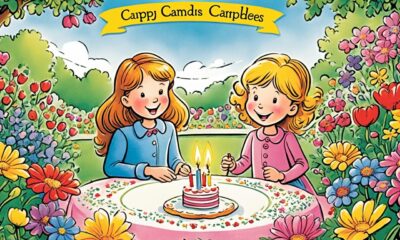
 Mom3 months ago
Mom3 months agoHeartfelt Poems for Your Daughter’s Birthday
-

 Mom3 months ago
Mom3 months agoHappy Birthday Religious Wishes and Blessings
-

 Mom3 months ago
Mom3 months agoHappy 65th Birthday: Celebrate Your Special Day!
-

 Mom3 months ago
Mom3 months agoHappy Birthday in Heaven from Daughter: Remembering You
-

 Mom3 months ago
Mom3 months agoCelebrating 60 Years: Happy 60th Birthday Wishes
-

 Mom3 months ago
Mom3 months ago62nd Birthday Quotes for Mom: Celebrate Her Special Day
-

 Mom3 months ago
Mom3 months agoCelebrate a Joyous Happy 70th Birthday Milestone!
-

 Mom3 months ago
Mom3 months agoHappy 61st Birthday: Celebrate This Special Milestone



















